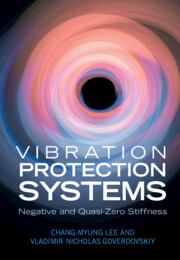Book contents
- Vibration Protection Systems
- Vibration Protection Systems
- Copyright page
- Contents
- Preface
- Acknowledgments
- Glossary
- 1 Vibrations Destroying Human–Machine Systems Inside and Outside
- 2 Vibration Protection Systems with Negative and Quasi-Zero Stiffness
- 3 Modeling of Elastic Postbuckling in Large and Dimensioning the Mechanisms with Negative Stiffness
- 4 The Type and Number Synthesis of Function-Generating Mechanisms
- 5 Dynamics of Systems with Sign-Changing Stiffness
- 6 Dynamics of Systems with Sign-Changing Stiffness
- 7 Dynamics of Systems with Sign-Changing Stiffness
- 8 Methods of Experimental Study of Vibration Protection Systems with Negative and Quasi-Zero Stiffness
- 9 In Harmony with Conventional Vibration Protection Systems
- 10 Development and Use of Vibration Protection Systems with Negative and Quasi-Zero Stiffness
- Index
- References
8 - Methods of Experimental Study of Vibration Protection Systems with Negative and Quasi-Zero Stiffness
Published online by Cambridge University Press: 29 October 2021
- Vibration Protection Systems
- Vibration Protection Systems
- Copyright page
- Contents
- Preface
- Acknowledgments
- Glossary
- 1 Vibrations Destroying Human–Machine Systems Inside and Outside
- 2 Vibration Protection Systems with Negative and Quasi-Zero Stiffness
- 3 Modeling of Elastic Postbuckling in Large and Dimensioning the Mechanisms with Negative Stiffness
- 4 The Type and Number Synthesis of Function-Generating Mechanisms
- 5 Dynamics of Systems with Sign-Changing Stiffness
- 6 Dynamics of Systems with Sign-Changing Stiffness
- 7 Dynamics of Systems with Sign-Changing Stiffness
- 8 Methods of Experimental Study of Vibration Protection Systems with Negative and Quasi-Zero Stiffness
- 9 In Harmony with Conventional Vibration Protection Systems
- 10 Development and Use of Vibration Protection Systems with Negative and Quasi-Zero Stiffness
- Index
- References
Summary
Simulation and instrumental measurement are the most reliable methods to examine, prove, and enhance adequacy of theoretical models and prototypes and predict their practical use. A trade-off complex of testing and measuring instruments is presented for designing vibration protection systems. This includes both the standard test equipment and add-on devices to recognize specifics in behavior of the systems with negative and quasi-zero stiffness. This covers the computer-aided tensile machines and special adapters for static and low-cycle testing, optical aids for holographic interferometry and structural testing, electro- and/or hydrodynamic exciters, sets of special infra-frequency accelerometers and external filters, AD/DA-boards, FFT- and/or wavelet analyzers, recording equipment, and standard and special software. The complex developed provides a full cycle of the system experiment, including (a) path-generation and optimization of elastic responses, (b) strain state analysis of parametric elements and mechanism units, (c) simulation and online analysis of dynamic behavior of scaled models of the systems with extremely small stiffness and damping under vibrations in a frequency range starting from near-zero values. The method of laboratory experiment is an integral part of the methodology to investigate the systems in the field.
Keywords
- Type
- Chapter
- Information
- Vibration Protection SystemsNegative and Quasi-Zero Stiffness, pp. 201 - 237Publisher: Cambridge University PressPrint publication year: 2021

